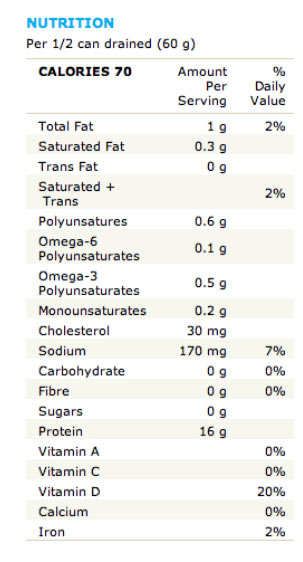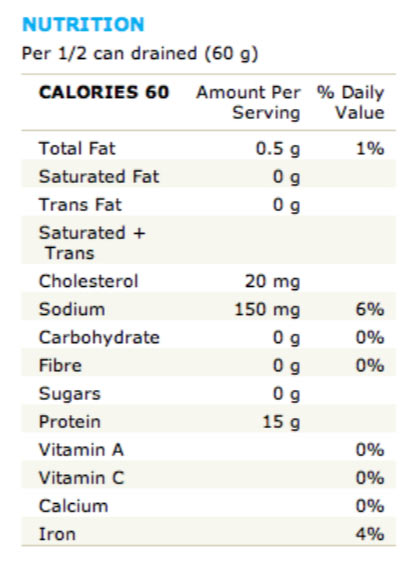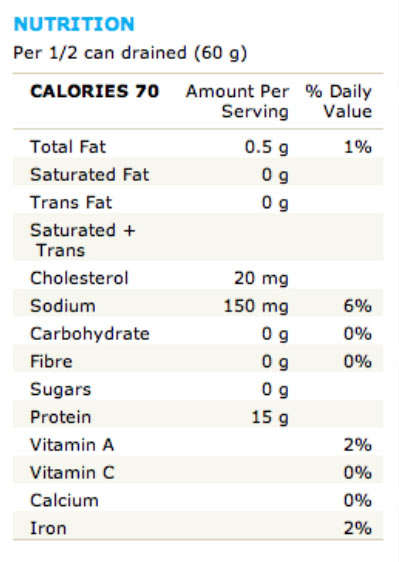Tuna is a great source of protein. Cheap, quick, and easy to use. Most times you can just pop open a can (packed in water of course) or sachet of tuna, and your ready-to-eat. Which tuna you choose is really up to you. The most popular forms of tuna packed in water are white tuna (albacore) , chunk light (yellowfin) and flaked light (skipjack).
Is there are difference nutritionally? Sure, but the difference is very slight. See for yourself.
Nutritionally – Calories per serving are about the same.
Based on the nutritional profiles given by these three Clover Leaf brands, the only different is about 1g of protein, and some OMG 3 – about -0.5g.
Price can be a determining factor when choosing a tuna, but taste is what is going to keep you coming back for more. I would experiment on which flavour you prefer – albacore, yellowfin or skipjack. It can get confusing since there are so many brands available, for instance you can get white tuna in solid, chunk, or light – but that is more of the preparation of the tuna, and how you would like to eat it (in chunks for smaller pieces). Albacore is lighter in taste, and is white to pinkish in color. Yellowfin is stronger in taste than albacore, with skipjack being darker and a fuller flavor than yellowfin.
And in case you did not know tuna is a cooked, and then canned.
If you are concerned about the sustainability of your tuna – Greenpeace ranked some popular tuna companies, and you can see the report here.
If you are blue around the gills to even consider eating tuna, there are always more fish (or protein) sources to choose from.
Mercury
When you speak of tuna one cannot ignore the concern for mercury. There is mercury in all fish with certain types having more mercury than others. Older fish are known to have more mercury than smaller, younger fish. Tuna has received a bad rap for this, much unlike eggs and their contribution to cholesterol. However, albacore tuna does possess more mercury than light tuna.
From Health Canada Website:CONSUMPTION ADVICE: MAKING INFORMED CHOICES ABOUT FISH)
Some types of fish have higher levels of these beneficial fatty acids than others. Fish and shellfish that contain higher levels of these fatty acids and are also low in mercury include: anchovy, capelin, char, hake, herring, Atlantic mackerel, mullet, pollock ( Boston bluefish), salmon, smelt, rainbow trout, lake whitefish, blue crab, shrimp, clam, mussel and oyster.
Types of fish that should be eaten less often
Health Canada has identified certain fish as being of more concern when it comes to mercury in fish. Fish can accumulate mercury in their muscles through absorption from the surrounding water but mostly from the prey that they eat. This mercury can also concentrate up the food chain. Therefore, predatory fish that eat lots of other fish for food tend to contain higher levels of mercury.
These include fresh/frozen tuna, shark, swordfish, marlin, orange roughy and escolar (Note: Additional health information on escolar is available from Health Canada’s Fact Sheet on escolar and ![]() CFIA’s fact sheet.
CFIA’s fact sheet.
Canadians who like to consume these types of fish can continue to do so, but should limit their consumption to the amounts shown in the table below. Other types of fish should be chosen to make up the rest of their recommended weekly fish consumption.
| General Population | Specified Women * | Children 5-11 years old | Children 1-4 years old |
| 150 g per week | 150 g per month | 125 g per month | 75 g per month |
* Specified women are those who are or may become pregnant or are breastfeeding.
150 grams represents two Food Guide servings and is equivalent to approximately one cup.
This advice does NOT apply to canned tuna. Information on canned tuna is provided in the next section.
Canned Tuna
Canned tuna, especially canned light tuna, is one of the most popular types of fish for many Canadians. The fish used in canned tuna products are generally younger and smaller and have significantly less mercury than fresh or frozen tuna, so that most Canadians don’t need to be concerned about consuming canned tuna.
However, for those who consume large amounts of canned albacore tuna, there is some potential for exposure to higher levels of mercury than is considered acceptable.
Because of this, Health Canada has issued advice for children and some women on the consumption of canned albacore tuna. The advice does not apply to canned light tuna, nor does it apply to Canadians outside of the specified groups.
Canned albacore tuna is also often called canned white tuna, but it is not the same as canned light tuna. Canned light tuna contains other species of tuna such as skipjack, yellowfin, and tongol, which are relatively low in mercury. Canned light tuna also tends to be lower in cost relative to albacore tuna.
Canned Albacore (White) Tuna Advice (does not apply to canned light tuna)
| Specified Women | Children 5-11 years old | Children 1-4 years old |
| 300 grams a week (4 Food Guide servings) | 150 grams a week (2 Food Guide servings) | 75 grams a week (1 Food Guide serving) |
* Specified women are those who are or may become pregnant or are breastfeeding.
One Food Guide Serving is 75g, 2 ½ oz, 125 mL, or ½ cup and is equal to about half of a 170-g can (a very common can size).
In January 2007, Health Canada began an extensive survey of mercury levels in canned tuna in Canada. Once this new information is available, the advice related to canned albacore tuna may be further adjusted as required.
Reference Dose For Mercury
*Daily Reference Intake: is the estimated amount you can safely consume without any long term health affects.
Health Canada has a tolerance daily intake level 0.47 micrograms/Kg of Bodyweight per day. They recommend sticking with fish that have a 0.2ppm or lower mercury content.
The Environment Protection Agency (EPA) and Federation Department of Agriculture (FDA) have listed some guidelines pertaining to the consumption of fish and a daily reference dose of 1 microgram/Kg Bodyweight per day. With this they also list some general guidelines for pregnant women, or children in the consumption of fish:
(from EPA website: WHAT YOU NEED TO KNOW ABOUT MERCURY IN FISH AND SHELLFISH
By following these three recommendations for selecting and eating fish or shellfish, women and young children will receive the benefits of eating fish and shellfish and be confident that they have reduced their exposure to the harmful effects of mercury.
- Do not eat Shark, Swordfish, King Mackerel, or Tilefish because they contain high levels of mercury.
- Eat up to 12 ounces (2 average meals) a week of a variety of fish and shellfish that are lower in mercury.
- Five of the most commonly eaten fish that are low in mercury are shrimp, canned light tuna, salmon, pollock, and catfish.
- Another commonly eaten fish, albacore (“white”) tuna has more mercury than canned light tuna. So, when choosing your two meals of fish and shellfish, you may eat up to 6 ounces (one average meal) of albacore tuna per week.
- Check local advisories about the safety of fish caught by family and friends in your local lakes, rivers, and coastal areas. If no advice is available, eat up to 6 ounces (one average meal) per week of fish you catch from local waters, but don’t consume any other fish during that week.
The World Health Organization (WHO) recommends a daily reference dose for mercury of 1.6 mcg/Kg of bodyweight per day.
(from WHO website: GUIDANCE FOR IDENTIFYING POPULATIONS AT RISK FROM MERCURY EXPOSURE – page 32
The Agency for Toxic Substances and Disease Registry (ATSDR) recommends a limit of 0.3 micrograms/Kg of Bodyweight per day.
(from the ATSDR website: REGULATIONS AND ADVISORIES)
To summarize:
So what if you wanted to actually track how much mercury you were ingesting. Well you can always do some math.
| PDI (µg/kg bw/day) = | fish muscle intake (g/day) x [methylmercury concentration (µg/g)]
average body weight (kg) |
|
Organization |
Daily Reference Dose (mg/Kg BW Per day) |
| EPA/FDA | 0.1 microgram/Kg of BW |
| WHO | 0.22 micrograms/Kg of BW |
| ATSDR
Agency for Toxic Substances & Disease Registry |
0.3 micrograms/Kg of BW per day |
| Health Canada | Children, pregnant women
0.2 micrograms/Kg of BW per day Adults 0.47 micrograms/Kg of Bw per day |
Here is a listing of various fish and shellfish and their levels of mercury. See here. Their mercury content is listed as PPM = parts per million.
Here are some other resources in which you can verify your consumption but depending on which reference dose they are using you could get a skewed response.
- Weekly Fish Intake Calculation
- Mercury Consumption Calculation
- Health Canada Q& A on Mercury and Fish consumption
Happy Fishing,
A.




